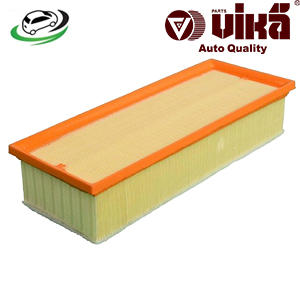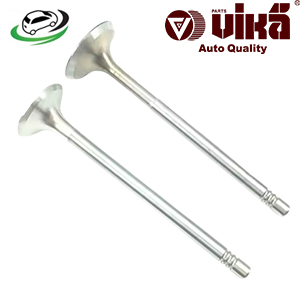-22%
Get Exhaust Valve For VW / AUDI 1.4L 1.6L 16V engines and 1.2L 12V engines 036109611K
The intake valve is a critical component in an internal combustion engine, responsible for allowing air (and sometimes fuel, in older carbureted engines) to enter the combustion chamber. Proper functioning of the intake valve is essential for engine performance, fuel efficiency, and emissions control. This guide provides an in-depth look at intake valves, including their functions, types, benefits, symptoms of failure, and maintenance.
Functions of Intake Valves
- Air Intake Regulation
- Purpose: The primary function of the intake valve is to regulate the flow of air into the combustion chamber. It opens at the right moment during the engine’s intake stroke to allow air to enter, providing the necessary oxygen for combustion.
- Timing: Intake valves are precisely timed to open and close in synchronization with the engine’s camshaft and crankshaft. This timing is crucial for optimal engine performance and efficiency.
- Fuel Mixture Preparation
- Carbureted Engines: In older carbureted engines, the intake valve also allows the air-fuel mixture to enter the combustion chamber. The carburetor mixes air and fuel before delivering it to the intake valve.
- Fuel Injection Systems: In modern fuel-injected engines, the fuel is injected directly into the combustion chamber or into the intake manifold. The intake valve still plays a key role in allowing the air to mix with the fuel.
- Engine Efficiency and Performance
- Optimal Air-Fuel Ratio: Proper operation of the intake valve ensures that the correct air-fuel ratio is maintained. This balance is essential for efficient combustion, which affects power output, fuel efficiency, and emissions.
- Volumetric Efficiency: The intake valve’s ability to open fully and close completely affects the engine’s volumetric efficiency. Better efficiency allows more air (and fuel) to enter the combustion chamber, improving performance.
- Emission Control
- Controlled Airflow: By regulating the airflow into the combustion chamber, the intake valve helps control the emission of pollutants. Proper valve function contributes to meeting emission standards and reducing environmental impact.
Types of Intake Valves
- Standard Intake Valves
- Construction: Typically made from heat-resistant alloys such as stainless steel or inconel, standard intake valves are designed to withstand high temperatures and pressures.
- Operation: These valves are operated by the camshaft and are used in most conventional internal combustion engines.
- Variable Valve Timing (VVT) Valves
- Technology: VVT technology allows the timing of the intake valve to be adjusted based on engine speed and load. This improves performance and fuel efficiency across a range of operating conditions.
- Benefits: VVT valves can optimize power output and reduce emissions by adjusting the timing and duration of the valve opening.
- Dual Overhead Cam (DOHC) Valves
- Design: In DOHC engines, there are two camshafts per cylinder bank—one for intake valves and one for exhaust valves. This design allows for precise control of valve timing and can improve engine performance and efficiency.
- Advantages: DOHC valves typically provide better airflow and performance compared to single overhead cam (SOHC) designs.
- Direct-Acting Valves
- Mechanism: In some high-performance engines, direct-acting valves are used. These valves are actuated directly by the camshaft without the need for rocker arms, allowing for quicker response and reduced valve train losses.
Benefits of Well-Maintained Intake Valves
- Improved Engine Performance
- Power Output: Properly functioning intake valves ensure that the engine receives the optimal amount of air (and fuel), leading to improved power output and acceleration.
- Throttle Response: Efficient intake valves contribute to better throttle response, making the vehicle more responsive to driver input.
- Enhanced Fuel Efficiency
- Optimized Combustion: By maintaining the correct air-fuel ratio and ensuring efficient airflow, well-maintained intake valves contribute to better fuel combustion and improved fuel efficiency.
- Reduced Emissions
- Compliance: Properly functioning intake valves help the engine meet emissions standards by ensuring efficient combustion and reducing the emission of pollutants.
- Extended Engine Life
- Reduced Wear: Regular maintenance and timely replacement of intake valves help reduce engine wear and prevent damage to other components, contributing to the engine’s longevity.
Symptoms of Failing Intake Valves
- Decreased Engine Performance
- Loss of Power: A failing intake valve can lead to reduced engine power and acceleration. This is often due to insufficient air (or air-fuel mixture) entering the combustion chamber.
- Poor Fuel Efficiency
- Increased Consumption: If the intake valves are not functioning properly, the engine may not achieve the optimal air-fuel ratio, leading to increased fuel consumption and reduced fuel efficiency.
- Engine Misfire
- Rough Running: Faulty intake valves can cause engine misfires, resulting in rough engine operation, hesitation, or stumbling during acceleration.
- Increased Emissions
- Emission Test Failure: A malfunctioning intake valve can lead to incomplete combustion, resulting in increased emissions and potential failure of emission tests.
- Abnormal Engine Noise
- Ticking or Knocking: Worn or damaged intake valves may produce abnormal noises, such as ticking or knocking, which can be heard from the engine compartment.
- Difficulty Starting the Engine
- Hard Starts: If the intake valves are not sealing properly, it can make starting the engine more difficult. This is often accompanied by rough idling or stalling.
Maintenance and Replacement
- Regular Inspection
- Visual Checks: Regularly inspect the intake valves for signs of wear or damage. This may involve removing the valve cover or intake manifold, depending on the engine design.
- Performance Monitoring: Pay attention to engine performance and address any symptoms of valve issues promptly.
- Cleaning
- Carbon Deposits: Intake valves can accumulate carbon deposits over time, affecting their performance. Using a fuel system cleaner or having a professional clean the valves can help maintain their efficiency.
- Replacement
- Valve Lifespan: Intake valves should be replaced according to the vehicle manufacturer’s recommendations or if they show signs of significant wear or damage.
- Professional Service: Valve replacement may require specialized tools and expertise. Consult a professional mechanic for accurate diagnosis and replacement.
Follow us on Facebook for more parts.



